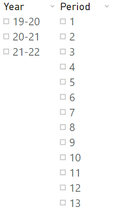- Power BI forums
- Updates
- News & Announcements
- Get Help with Power BI
- Desktop
- Service
- Report Server
- Power Query
- Mobile Apps
- Developer
- DAX Commands and Tips
- Custom Visuals Development Discussion
- Health and Life Sciences
- Power BI Spanish forums
- Translated Spanish Desktop
- Power Platform Integration - Better Together!
- Power Platform Integrations (Read-only)
- Power Platform and Dynamics 365 Integrations (Read-only)
- Training and Consulting
- Instructor Led Training
- Dashboard in a Day for Women, by Women
- Galleries
- Community Connections & How-To Videos
- COVID-19 Data Stories Gallery
- Themes Gallery
- Data Stories Gallery
- R Script Showcase
- Webinars and Video Gallery
- Quick Measures Gallery
- 2021 MSBizAppsSummit Gallery
- 2020 MSBizAppsSummit Gallery
- 2019 MSBizAppsSummit Gallery
- Events
- Ideas
- Custom Visuals Ideas
- Issues
- Issues
- Events
- Upcoming Events
- Community Blog
- Power BI Community Blog
- Custom Visuals Community Blog
- Community Support
- Community Accounts & Registration
- Using the Community
- Community Feedback
Register now to learn Fabric in free live sessions led by the best Microsoft experts. From Apr 16 to May 9, in English and Spanish.
- Power BI forums
- Forums
- Get Help with Power BI
- Desktop
- Re: Help with Multiple Filters from User Selection...
- Subscribe to RSS Feed
- Mark Topic as New
- Mark Topic as Read
- Float this Topic for Current User
- Bookmark
- Subscribe
- Printer Friendly Page
- Mark as New
- Bookmark
- Subscribe
- Mute
- Subscribe to RSS Feed
- Permalink
- Report Inappropriate Content
Help with Multiple Filters from User Selection Slicers
Hi,
I have a calendar table which has columns Year and Period that I'm using as slicers:
I'm using these to filter out data from 6 data tables; these 6 tables also contain the columns Year and Period. When I previously had data for Year 19-20 only the figures were calculated correctly but when I've now added data for Year 20-21 I'm getting a summation of Years 19-20 and 20-21 instead of just the Year and Period selected.
I have the following data as an example:
The slicers are as follows:
When I select the Year and Period then the calculations are made based on this user selection. I have the following KPIs that I'm calculating:
Solved! Go to Solution.
- Mark as New
- Bookmark
- Subscribe
- Mute
- Subscribe to RSS Feed
- Permalink
- Report Inappropriate Content
A bit tricky, but a disconnected table trick and this measure later and I think I got it. PBIX is attached:
SIP Actual Line Chart =
VAR __Year = MAX('SIP_Activities'[Year])
VAR __Period = MAX('SIP_Activities'[Period]) + 0
VAR __LinePeriod = MAX('Periods'[Period]) + 0
VAR __Table = FILTER(ALL(SIP_Activities),[Year] = __Year && [Period]+0 <= __Period)
VAR __Table1 = FILTER(__Table,[Period]+0 = __LinePeriod)
RETURN
SUMX(__Table1,[Actual-LD]) + SUMX(__Table1,[Late Delivery])@ me in replies or I'll lose your thread!!!
Instead of a Kudo, please vote for this idea
Become an expert!: Enterprise DNA
External Tools: MSHGQM
YouTube Channel!: Microsoft Hates Greg
Latest book!: The Definitive Guide to Power Query (M)
DAX is easy, CALCULATE makes DAX hard...
- Mark as New
- Bookmark
- Subscribe
- Mute
- Subscribe to RSS Feed
- Permalink
- Report Inappropriate Content
Thank you very much @Greg_Deckler , that did the trick.
If I want to apply this to other tables and columns, do I need to change anything such as the variable names?
- Mark as New
- Bookmark
- Subscribe
- Mute
- Subscribe to RSS Feed
- Permalink
- Report Inappropriate Content
The variable names can stay the same, the overall name of the measure needs to be unique
SIP Actual Line Chart =
VAR __Year = MAX('SIP_Activities'[Year])
VAR __Period = MAX('SIP_Activities'[Period]) + 0
VAR __LinePeriod = MAX('Periods'[Period]) + 0
VAR __Table = FILTER(ALL(SIP_Activities),[Year] = __Year && [Period]+0 <= __Period)
VAR __Table1 = FILTER(__Table,[Period]+0 = __LinePeriod)
RETURN
SUMX(__Table1,[Actual-LD]) + SUMX(__Table1,[Late Delivery])
Red is the measure name, has to be unique. Green are table names that you would update. Blue is column names that you would update. You could leave the measure names the same although the names may not make total sense depending on your tables/periods, etc. that you are switching things to.
@ me in replies or I'll lose your thread!!!
Instead of a Kudo, please vote for this idea
Become an expert!: Enterprise DNA
External Tools: MSHGQM
YouTube Channel!: Microsoft Hates Greg
Latest book!: The Definitive Guide to Power Query (M)
DAX is easy, CALCULATE makes DAX hard...
- Mark as New
- Bookmark
- Subscribe
- Mute
- Subscribe to RSS Feed
- Permalink
- Report Inappropriate Content
Helpful resources

Microsoft Fabric Learn Together
Covering the world! 9:00-10:30 AM Sydney, 4:00-5:30 PM CET (Paris/Berlin), 7:00-8:30 PM Mexico City

Power BI Monthly Update - April 2024
Check out the April 2024 Power BI update to learn about new features.

| User | Count |
|---|---|
| 113 | |
| 103 | |
| 76 | |
| 66 | |
| 63 |
| User | Count |
|---|---|
| 142 | |
| 105 | |
| 102 | |
| 81 | |
| 68 |



